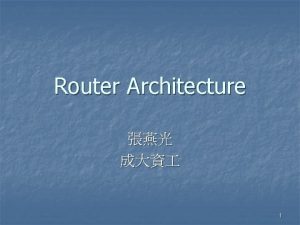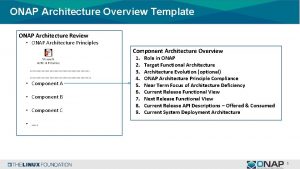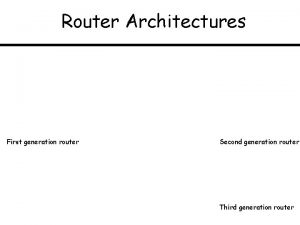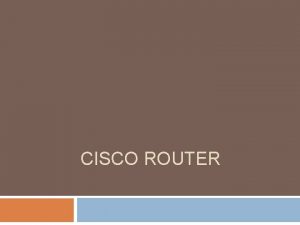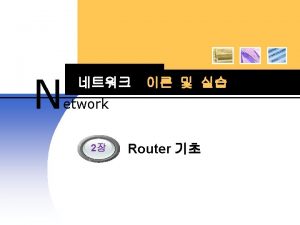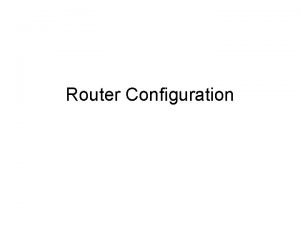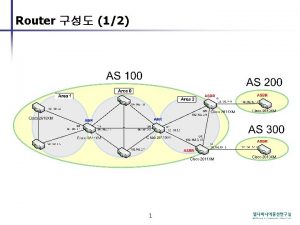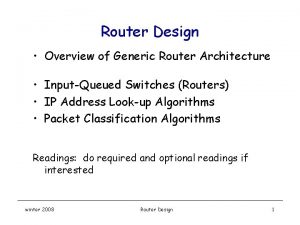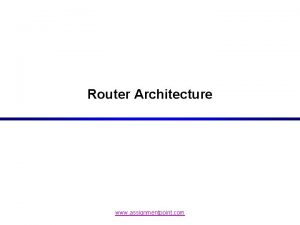Router Architecture Overview Two key router functions run















- Slides: 15

Router Architecture Overview Two key router functions: • run routing algorithms/protocol (RIP, OSPF, BGP) • switching datagrams from incoming to outgoing link

Input Port Functions Physical layer: bit-level reception Data link layer: e. g. , Ethernet see chapter 5 Decentralized switching: • given datagram dest. , lookup output port using routing table in input port memory • goal: complete input port processing at ‘line speed’ • queuing: if datagrams arrive faster than forwarding rate into switch fabric

Input Port Queuing • Fabric slower that input ports combined -> queueing may occur at input queues • Head-of-the-Line (HOL) blocking: queued datagram at front of queue prevents others in queue from moving forward • queueing delay and loss due to input buffer overflow!

Three types of switching fabrics

Switching Via Memory First generation routers: • packet copied by system’s (single) CPU • speed limited by memory bandwidth (2 bus crossings per datagram) Memory Input Port Output Port System Bus Modern routers: • input port processor performs lookup, copy into memory • Cisco Catalyst 8500

Switching Via Bus • datagram from input port memory to output port memory via a shared bus • bus contention: switching speed limited by bus bandwidth • 1 Gbps bus, Cisco 1900: sufficient speed for access and enterprise routers (not regional or backbone)

Switching Via An Interconnection Network • overcome bus bandwidth limitations • Banyan networks, other interconnection nets initially developed to connect processors in multiprocessor • Advanced design: fragmenting datagram into fixed length cells, switch cells through the fabric. • Cisco 12000: switches Gbps through the interconnection network

Output Ports • Buffering required when datagrams arrive from fabric faster than the transmission rate • Scheduling discipline chooses among queued datagrams for transmission

Output port queueing • buffering when arrival rate via switch exceeeds ouput line speed • queueing (delay) and loss due to output port buffer overflow!

IPv 6 • Initial motivation: 32 -bit address space completely allocated by 2008. • Additional motivation: – header format helps speed processing/forwarding – header changes to facilitate Qo. S – new “anycast” address: route to “best” of several replicated servers • IPv 6 datagram format: – fixed-length 40 byte header – no fragmentation allowed

IPv 6 Header (Cont) Priority: identify priority among datagrams in flow Flow Label: identify datagrams in same “flow. ” (concept of“flow” not well defined). Next header: identify upper layer protocol for data

Other Changes from IPv 4 • Checksum: removed entirely to reduce processing time at each hop • Options: allowed, but outside of header, indicated by “Next Header” field • ICMPv 6: new version of ICMP – additional message types, e. g. “Packet Too Big” – multicast group management functions

Transition From IPv 4 To IPv 6 • Not all routers can be upgraded simultaneous – no “flag days” – How will the network operatewith mixed IPv 4 and IPv 6 routers? • Two proposed approaches: – Dual Stack: some routers with dual stack (v 6, v 4) can “translate” between formats – Tunneling: IPv 6 carried as payload n IPv 4 datagram among IPv 4 routers

Dual Stack Approach

Tunneling IPv 6 inside IPv 4 where needed
 Long run perfect competition equilibrium
Long run perfect competition equilibrium Run lola run theme
Run lola run theme Run lola run editing techniques
Run lola run editing techniques Short run vs long run economics
Short run vs long run economics Multirule plus
Multirule plus Long run market supply curve
Long run market supply curve Run lola run script
Run lola run script Lolas nn
Lolas nn Switch fabric
Switch fabric Router architecture
Router architecture Architecture review template
Architecture review template Stylistic overview
Stylistic overview Hlr and vlr in gsm
Hlr and vlr in gsm Overview of grid architecture
Overview of grid architecture Overview of oracle architecture
Overview of oracle architecture Example of business model canvas
Example of business model canvas









